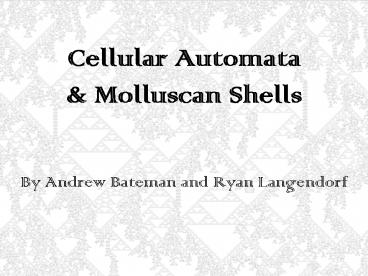Cellular Automata - PowerPoint PPT Presentation
1 / 40
Title:
Cellular Automata
Description:
Cellular Automata & Molluscan Shells. By Andrew Bateman and Ryan Langendorf. Cellular Automata ... The outer edge of the mantle lays down calcium carbonate ... – PowerPoint PPT presentation
Number of Views:416
Avg rating:5.0/5.0
Title: Cellular Automata
1
Cellular Automata Molluscan Shells
- By Andrew Bateman and Ryan Langendorf
2
Cellular Automata
3
- Wolfram class I
- Wolfram class II
- Wolfram class III
- Wolfram class IV
4
Where Did That Shell Come From?
- The outer edge of the mantle lays down calcium
carbonate crystals in a protein matrix. - The periostracum is the outer, organic layer that
both protects the shell and gives it its pattern.
5
Shell Patterns What Do We Know?
- Not much!
- Evolutionary advantage?
- Cone shells have vibrant patterns to warn of
their poison - Ermentrout, Campbell, and Oster say none
- Pigments get permanently laid down over time in a
synchronized manner along the leading edge - There is likely interaction between the cells
laying down the pigments
6
Why Bother With Cellular Automata?
- The mathematicians answer
- They look right.
- The (mathematical) biologists answer
- Local Effects of activation and inhibition
dominate pigment, and thus pattern,
production.
7
Activation Inhibition
8
Kusch Markus Propose The Meaning of (Marine)
Life
9
(No Transcript)
10
What Makes It Tick?
Biology
Math
decay of the inhibitor
random activation and expression of gene
production of the inhibitor
activation when lots of activated cells in the
neighbourhood
quantity of inhibitor in the neighbourhood
deactivation when lots of inhibition
11
What can such a simple model produce?
12
(No Transcript)
13
(No Transcript)
14
(No Transcript)
15
(No Transcript)
16
(No Transcript)
17
Strengths limitations
- Strengths
- The patterns resemble those on the shells
- Biology
- Activation/inhibition is taken into account
- All shells can be generated from the same set of
rules - In real life all the shells are made in a similar
fashion - Limitations
- Patterns differ in details and regularity
- Tenuous biological connection
- Scale?
- Why use specific parameters?
- How derive the specific rules?
18
Our Improvement Multiple Genes
19
Biology Of Our Model
- There are two types of patterns on some shells.
- This indicates there might be multiple genes
involved in the creation of the patterns. - Activation and inhibition is still assumed to be
the mechanism behind the production of the
patterns.
20
Playing God
Refresher
- Activation is randomly triggered and then
spreads. - As it spreads inhibitor builds up.
- Once the inhibitor reaches a threshold level
deactivation occurs. - The inhibitor then decreases.
Our Twist
- If a cell in deactivated, there is a lot of
activated cells around it, and there is a lot of
inhibitor around it, then a second gene is
activated. - The background color produced while this second
gene is active is different. - The inhibitor decreases over time.
- Once the inhibitor drops below a threshold level
the gene is deactivated and pigment production
reverts to its previous state.
21
Two Genes
One Gene
Actual Pattern
22
(No Transcript)
23
Asynchronous
24
(No Transcript)
25
(No Transcript)
26
(No Transcript)
27
(No Transcript)
28
(No Transcript)
29
Are Kusch, Markus, And We God?
- If all shells are created in similar ways, why do
some versions of the model require the inhibitor
to decay linearly and others for it to decay
exponentially? - Is gene activation random?
- How is a neighbourhoods effect on a cell
evaluated? - Is it realistic to have only inhibitor toggling a
gene on and off? - When a new gene is expressed, is color the only
thing changed? Should the pattern differ as well?
30
Real Life??
- The patterns generated with two genes were more
realistic, but still different from the actual
ones. - Our multiple gene model is an extension of one we
deem questionable in its biological groundings. - Multiple genes?
31
In an abalone one color is exclusively associated
with a specific gene. Perhaps the colors on cone
shells are similarly controlled, and thus
further genetic research is warranted in species
displaying such patterns.
32
A New Kind Of Science?
- If there are multiple genes at work, how do they
interact, if at all? - Diffusion equations?
- Neural models?
- A new style of art?
33
(No Transcript)
34
(No Transcript)
35
(No Transcript)
36
(No Transcript)
37
(No Transcript)
38
(No Transcript)
39
Everything which is computable can be
computed with a cellular automaton - W.
Poundstone As regards cellular automata models,
they make no connection with any of the
underlying biological processes - J.D.
Murray
40
Made Possible By
A sincere thanks to Mark and Tomas, without whom
this project would not have been realized.
de Vries, G, et al. A Course in Mathematical
Biology Murray, J.D. Mathematical Biology Kusch,
I. and M. Markus. Mollusc Shell Pigmentation
Cellular Automaton Simulations and Evidence for
Undecidability http//www.stephenwolfram.com/publ
ications/articles/ca/84-universality/9/text.html h
ttp//mathworld.wolfram.com/ElementaryCellularAuto
maton.html http//math.hws.edu/xJava/CA/ http//ww
w.weichtiere.at/english/gastropoda/terrestrial/esc
argot/shell.html http//www.sealifegifts.net/nauti
cal_decorations.html http//cephalopodia.blogspot.
com/2007/02/five-deadly-animals-that-may-save-your
.html http//www.biochemistry.unimelb.edu.au/resea
rch/res_livett.htm http//www.scuba-equipment-usa.
com/marine/JUN05/Textile_Cone_Shell(Conus_textile)
.html http//en.wikipedia.org/wiki/Asynchronous_Ce
llular_Automaton http//online.sfsu.edu/psych200/
unit5/52.htm http//www.art.com/asp/sp-asp/_/pd--1
3060293/sp--A/Jaguar_CloseUp_of_Fur_Pattern_Pantan
al_Brazil.htm































